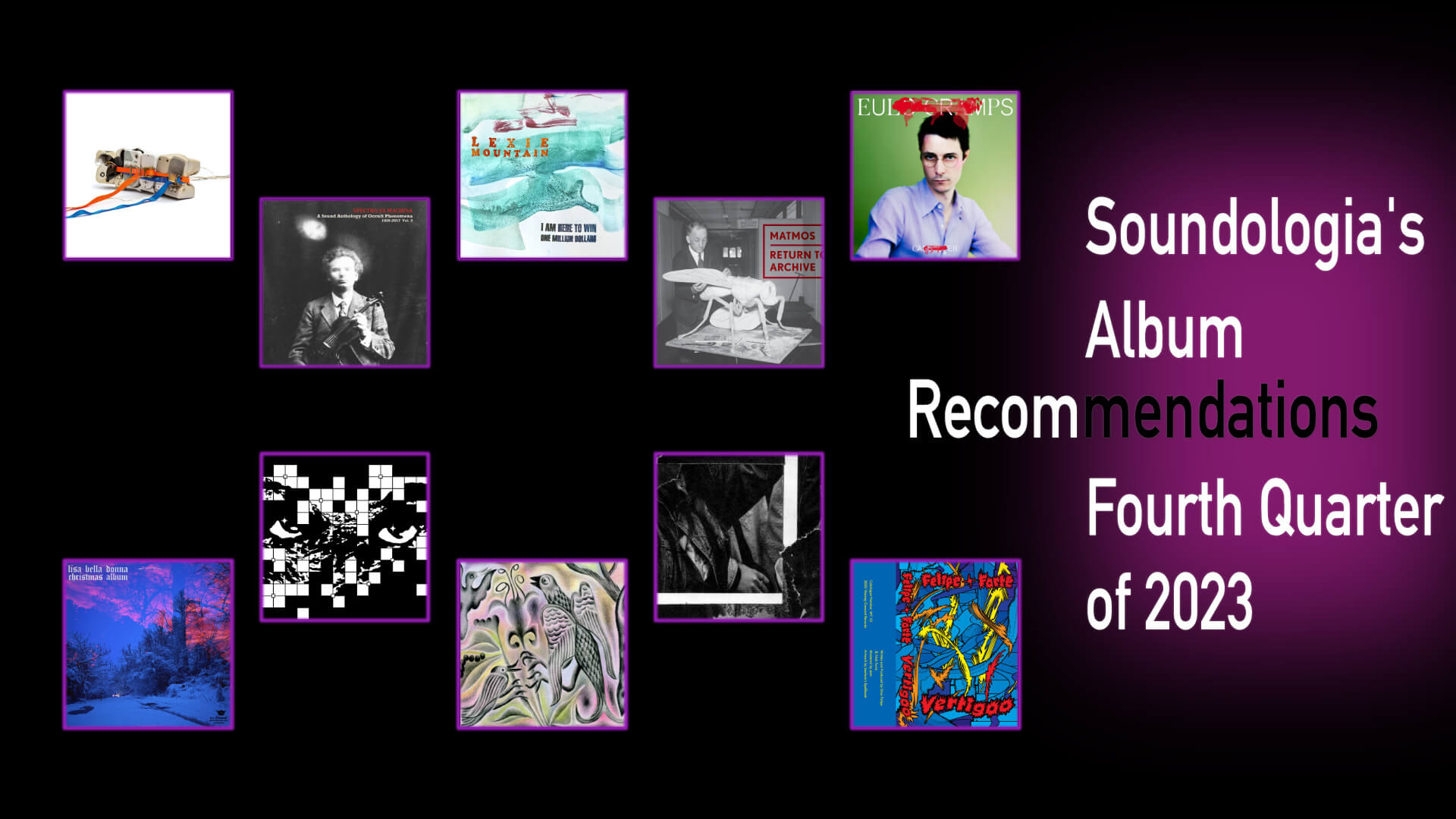
New and Experimental Music,
Art & Technolgy

New and Experimental Music,
Art & Technolgy

Welcome to Soundologia’s quarterly album recommendation list of 10 albums. We have selected these albums from the final months of 2023 (published on Bandcamp between October and December 2023). In this edition, we have curated a collection of albums across different genres within experimental and electronic music. We strongly suggest listening with headphones.
1. Francisco Meirino & Altar Of Flies – Exhausted, we fall
Are you struggling to maintain focus when reading lengthy texts? Do you find it challenging to maintain focus while listening to lengthy tracks? Is it considered a form of sound art that stimulates our minds and leaves us fulfilled rather than exhausted after spending hours immersed in the noise?
Even if you have a short attention span, you may still find yourself captivated by the flow of these two tracks, which combine magnetic tape, electronics, and field recordings to create a refined sound. While the first track doesn’t fully unleash its energy as it remains stagnant over time, side B follows a trajectory, gradually building up the sound until it reaches its boiling point.
2. Lisa Bella Donna – Christmas Album
The Moog female champion, Lisa Bella Donna, has sent us a Christmas message capturing a magical winter scene.
It has no intro. The album opens with the track “Rahmenerzählung,” which has a full range of frequency spectrum with arpeggiated chords and deep basses that create a polyphonic interplay across the stereo fields while melodies move from left to right and vice versa, creating a dynamic listening experience. As we approach the holidays, let’s take a moment to relax and enjoy the gloomy and mysterious ambiance of “Wednesday Morning.” The slightly untuned and saturated piano sound adds a unique weight to the main melody, creating a static and captivating tone. The track “Piece for Flute & Organ” flows seamlessly, with subtle and little anemic harmonic progressions. “Blizzard Of ’78” introduces a unique, synthesized sound palette, setting it apart from the previous tracks. The prickly and plucky tones, along with their echoing effects, beautifully capture the glittering and scattering icicles. The final track, “Country Snowstorm,” evokes a serene winter atmosphere in the countryside, where nature lies dormant beneath a white blanket. Ambient drones create a gradual musical progression that mimics the wind, snowflakes, or a rushing torrent. At times, solo instruments like a softly resonating trumpet or flute make an appearance, serving as a gentle reminder to appreciate the wonders of winter.
3. Various Artists – Spectra Ex Machina / A Sound Anthology of Occult Phenomena 1920-2017 Vol.2
Is there survival after death?
Let’s explore occult tradition and spiritualism, where people claim to receive communication from the dead. They use esoteric supernatural beliefs and practices, acting as a medium for famous people who have passed away to channel their ideas.
Music plays a significant role in this communication, with psychics using direct-voice mediumship to bring back composers and their music after death. Leslie Flint, a British psychic, communicated with Chopin, while pianist Rosemary Brown claimed contact with the spirit composers like Beethoven, Schubert, Schumann, Brahms, and Liszt, who gave her instructions to create extraordinary pieces. Music experts, musicologists, and theoreticians have investigated those pieces and acknowledged their supernatural origin. There is a recording of a séance led by Carmen Rogers with Elvis Presley in 1979 at a Spiritualist Church in North London. Titled “I Cannot Answer You,” this song is inspired by an illusionist, magician, television star, and self-proclaimed psychic.
The three volumes of the Sub Rosa Label’s anthology bring back a rare and valuable audio archive showcasing the history of parapsychology and occult ceremonies. Volume 2, “The Anthology Spectra Ex Machina,” contains recordings that capture the intense and moving moments of séances, along with music that profoundly connects with our emotions, imagination, and hearts.
4. Call Super – Eulo Cramps
The sounds and instruments in this album evoke folklore and oriental traditions, while the wind and string instruments, along with the female vocalist, create a harmonious symphony. The distorted sound adds a touch of mud, giving it a gritty allure. Rhythmic patterns guide each song, accompanied by electronic synth sounds. The artist fearlessly explores diverse sounds and instruments throughout the album without trying to elevate any one song above the others in popularity.
5. Oneohtrix Point Never – Again
Musicians tune their instruments before the conductor cues them to start playing an Adagio for string instruments. Let the journey begin with a bang! That’s how this album kicks off.
When will we tire of the vocoder? It seemed like it would be used throughout the album, but hopefully only occasionally. However, the distorted guitar, ambient synth drones, and arpeggiated synths with vocals take us back to the distant past. World Outside has interesting arrangements with electronic synths, vocals, and even strings that come together to make the music burst into small particles, but that happens a little later in Plastic Antique. The tremolo effect by string instruments in Gray Subviolet brings us back to the concert hall after the first song.
The album follows a gradual curve. However, The Body Trail and Nightmare Paint have the most energy that moves our body and mind. With album artwork by Matias Faldbakken, this album tends to be conceptual.
6. Matmos – Return to Archive
The latest LP from Matmos, an experimental electronic duo hailing from Baltimore, is a sonic journey through a vast array of sounds. From animal noises to wind and storms, untuned pianos, lasers, ice cubes, and even alien conversations, this album is a rich tapestry of sonic experimentation. The ethereal whispers of the ionosphere and the haunting screams of a soprano voice add an otherworldly dimension to the mix. Matmos transforms the raw power of lions roaring into a human-like roar, further blurring the boundaries between nature and technology.
This album was born out of Matmos’ invitation to create music in honor of Folkways Records’ 75th anniversary. In Return to Archive, the title of this LP, you will experience the joy of listening to a hundred samples that Matmos has selected from the non-musical sounds released on Folkways. Not only will you appreciate the music, but you will also learn about the remarkable individual Moses Asch, who established the iconic independent label Folkways Records, which has had a lasting impact on the history of music. Even after seventy-five years, the album carries the spirit and passion of Moses, who dedicated himself to recording and releasing music from all corners of the world.
7. Felipe + Forté – Vertigoo
Is the screen flickering while you’re listening to glitchy sound? That’s what you can expect when listening to Nick Forté and Dino Felipe’s new album.
I became familiar with Dino’s music when I lived in Miami. I’ve always admired his electronic and alternative music, and this album confirms his talent for sound experimentation. While the initial tracks may appear to be repetitive loops, the second song, “Vertigoloop,” introduces a touch of sweetness with its combination of live and processed loops. The album explores various combinations of timbre. “Easturnz” begins with the guitar and muffled jews harp evolving into heavy crushing of percussion and noise. Certain songs have distinct contrasting sections that repeat the opening theme. This is evident in “Sluice Horn,” which follows the ABA form. It starts with a cinematic vibe, shifts to rhythmic grooves on a slightly untuned guitar, and then returns to the original theme. Similarly, “Gamma Land” exhibits dynamic oscillations, mimicking the sound of tuning an analog radio between stations.
8. Lexie Mountain – I Am Here To Win One Million Dollars
“Just chopping it up”!
Experimenting with the voice and exploring different expressions is the primary focus of I Am Here To Win One Million Dollars by Lexie Mountain. Through vocal loops that are recorded, chopped, processed, and layered on top of each other, a wide range of expressions is achieved. These loops create narratives, dialogues, and conversations that either occur once or circulate as feedback. When a voice is processed with electronics, it becomes an instrument capable of producing incredible sound.
There are many ways to experiment with a voice, and Lexie’s work is distinct from other artists, such as Pamela Z. While seeing Lexie perform live would be even more thrilling, listening to this album in the comfort of your own room with good loudspeakers or headphones allows you to fully immerse yourself in the ambiance of multiple voices. This creates a choir-like effect that fills the space and generates a cacophony.
9. Various Artists – Synthetic Bird Music
This album is dedicated to showcasing the beauty of nature. Birds play a central role in this album, as they are closely intertwined with their environment. Some well-known composers, like Clément Janequin, Olivier Messiaen, Ottorino Respighi, and Einojuhani Rautavaara, drew inspiration from birdsong. Modern music makers and producers now use circuitry and software, like MAX MSP and other sound design tools, to program music and imitate the sounds of birds. We hear a wide range of vocalizations, emotions, and even body language expressed by birds. Field recordings are used to add authenticity to bird sounds.
However, the presence of humans poses a threat to their habitat. The intention of this album is to shed light on the ecological resignation and indifference of mankind. It features a compilation of 32 artists from various parts of the world who have delved into the world of birds to bring it closer to us. Some tracks, like “Wind Up Paradise Birds,” incorporate acoustic instruments such as winds, brass, strings, and even piano, reminiscent of the second movement of Rautavaara’s “Cantus Arcticus,” op. 61. Other tracks, like “Vögel Unserer Heimat,” experiment with different synthesis techniques such as ring modulation, frequency modulation, and amplitude modulation, demonstrating the availability of synthetic birdsong. However, it raises the question: do we still rely on an ecosystem for authentic bird experiences?
10. G Jones – Paths
I’m not seeking a track killer. However, we can find a few here.
The album brings a chilling morning with optimism just around the corner. However, it went too far in “Too Far Gone” and “Which Way.” Are we tired of the repetitive four-bar loops throughout the tracks? That could be the case, but there are still some tracks that DJs would likely enjoy playing. Unfortunately, the vinyl edition is unavailable.
Many of the tracks share similarities, with “Glowing Experience” and “Liminality” resembling “Which Way” like two remixes. Can we get any cool piano tune like “In Our Room” before we encounter familiar sounds from earlier tracks, such as “Dancing on The Edge.” Those loops are based on glitchy, distorted, yet captivating high-pitched rhythmic patterns. Using the same key throughout the songs can become a bit monotonous.
Roy Werner – Imagine My Surprise